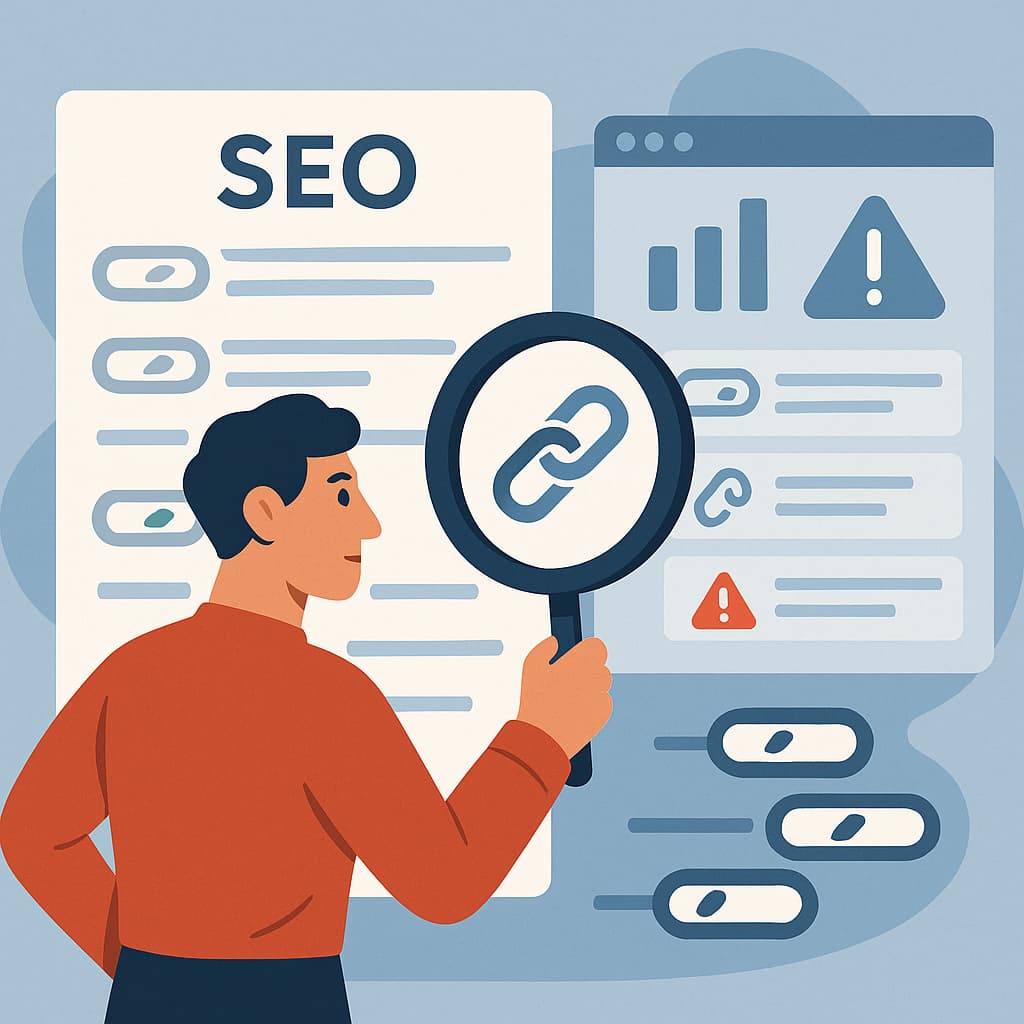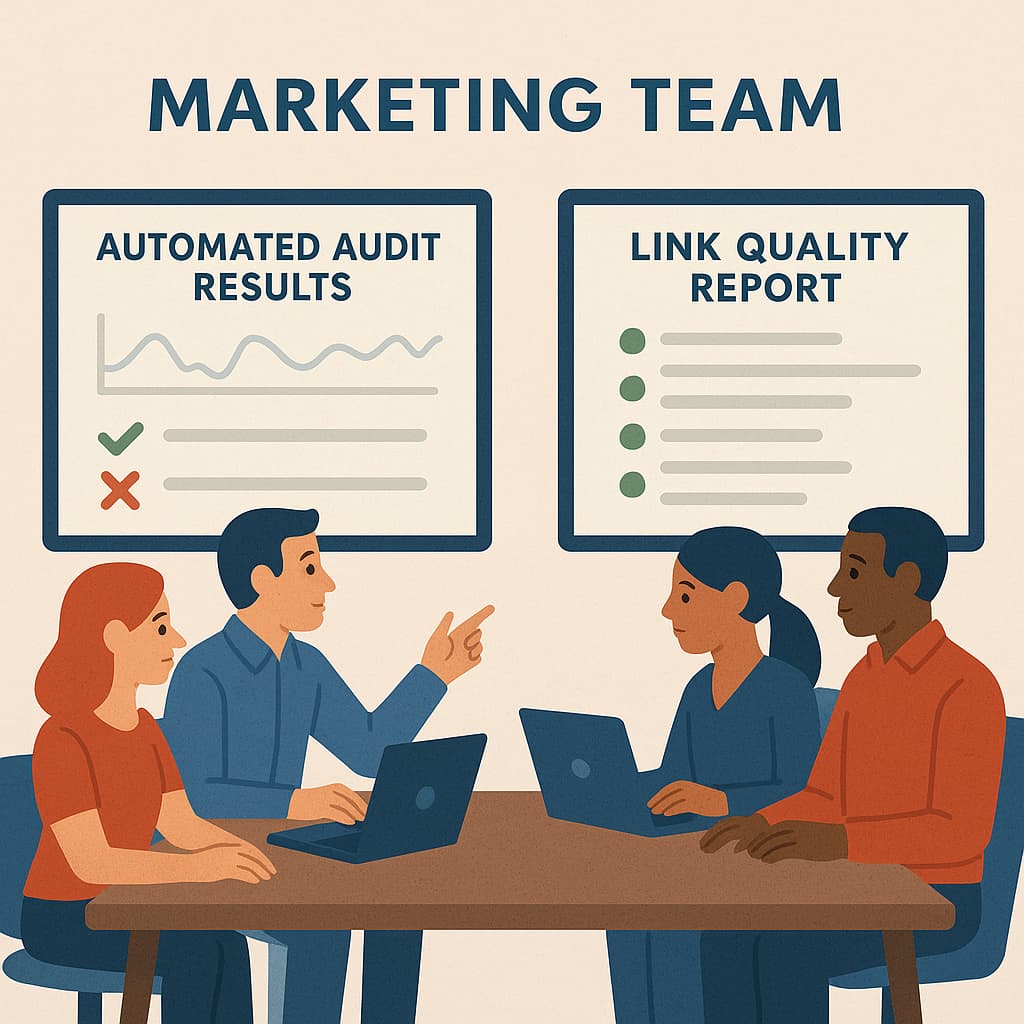Did you realize that even one harmful backlink may harm your rankings? This is why regular link audits are essential in SEO. But, with two major approaches—automated scans and manual reviews—how can you choose the best one? We compare both approaches so you may make an educated decision.
What Is a Link Building Audit?
A link-building audit examines a website’s backlinks to identify their quality, relevancy, and effect on SEO. It assists in identifying both quality connections that increase results and toxic or spammy links that may result in search engine penalties.
SEO specialists consider link sources, anchor text, domain authority, and potential penalties. This enables organizations to fine-tune their strategy, eliminate unwanted connections, and establish a stronger backlink profile. Finally, the audit verifies that backlinks help, not harm, a site’s organic growth.
What Are Automated Link Building Audits?
An automated link audit uses tools to analyze a website’s backlinks quickly. Instead of manual checks, it flags toxic links, broken links, low-quality backlinks, and areas for improvement.
These audits often evaluate aspects such as link quality, including whether the connections are from spammy or reputable sources. They also check anchor text distribution to see if it is over-optimized or natural. Another important issue is finding damaged or missing links, which are no longer functional. Furthermore, automated audits can identify competitor backlink gaps, suggesting chances to obtain equivalent high-quality connections.
Pros of Automated Audits
Automated audits save SEO professionals time by quickly analyzing large link sets. They spot backlink issues faster than manual reviews, offering actionable insights. Their efficiency makes them essential for scalable, accurate link analysis.
- Fast Results – Tools can analyze thousands of links in minutes, making them ideal for large websites.
- Consistency – Algorithms apply the same rules to every link, reducing human error.
- Competitor Analysis – Automated tools easily compare your backlink profile with competitors’.
- Toxic Link Detection – Many tools automatically flag suspicious links based on domain authority, spam scores, or past penalties.
Cons of Automated Audits
Automation is effective, but it has drawbacks that might affect a link audit’s precision and comprehensiveness. Correct evaluation of results still requires human judgment.
- Inaccurate Results – Tools sometimes flag good links as toxic or miss subtle spam signals.
- Lacks Human Judgment – Automated scans can’t evaluate link relevance or editorial quality.
- Overemphasis on Metrics – Relying too much on DA or Trust Flow can be misleading—these scores don’t always equal real value.
What Are Manual Link Building Audits?

Manual link audits require an SEO expert to review each backlink individually—no automation, just human analysis. While tools scan quickly but lack context, a professional can instantly detect unnatural or spammy links and assess their real value.
This hands-on approach also reveals hidden opportunities, such as broken connections that need to be restored or potential partnerships, as well as making better choices on gray-area links (such as forum mentions). Furthermore, skilled auditors see competitive insights and trends that tools overlook, giving your SEO plan an advantage.
Pros of Manual Audits
Manual audits offer depth and detail that automated tools cannot achieve. Using human expertise, these audits can identify insights that algorithms may overlook.
- Context Matters – Humans can spot unnatural or manipulative links better than tools.
- Recover Lost Value – Manual checks find broken links that were once valuable.
- Gray-Area Decisions – Some links (like forum mentions) need human judgment.
- Smarter Opportunities – Experts catch link-building chances that tools miss.
Cons of Manual Audits
Manual audits give you more detailed insights, but they take longer and don’t scale well compared to automated tools. This makes them less efficient and harder to maintain consistently across large projects.
- Time-Consuming – Reviewing hundreds or thousands of links manually takes significant effort.
- Higher Cost – Hiring an expert or agency for a manual audit is more expensive than using a tool.
- Subjectivity – Different analysts may have varying opinions on what constitutes a “toxic” link.
Which Approach is Better?
When it comes to maintaining a strong backlink profile, businesses tend to disagree on whether automatic technologies or manual audits are more efficient. The fact is that a hybrid strategy that combines automation with human expertise produces the greatest outcomes.
1. Start with Automated Scans for Efficiency
Running a backlink audit manually? That sounds like a nightmare. Why waste hours checking links one by one when tools like Ahrefs, SEMrush, or Moz can do the heavy lifting in minutes? These tools instantly flag toxic links—you know, the shady ones from spam sites or sketchy domains that could tank your rankings. They’ll also spot broken links (bad for user experience) and weird linking patterns that might raise red flags with Google.
If your site has tons of backlinks, automation is a lifesaver. There’s no way you’d want to comb through thousands manually. Instead, let the tools filter out the junk first, so you can focus your time on the links that actually need a closer look. This combo of automation + human review keeps your audit efficient and thorough.
2. Follow Up with Manual Review for Accuracy
Automated tools can flag potential backlink issues, but they often make mistakes. Many harmless or valuable links get incorrectly marked as toxic, which is why human review is critical. Low-authority links might still be relevant and natural, while industry-specific sources could provide real value despite lower metrics. Only manual checks can accurately assess a link’s true intent.
Skipping this step risks removing good links or keeping harmful ones—manual review ensures you make the right calls for your backlink profile.
3. Implement Continuous Monitoring
Think of your backlink profile like a garden—it needs regular care, not just a one-time cleanup. New toxic links can appear without warning, while previously good links might lose their value over time. That’s why we recommend monthly or quarterly monitoring to:
- Identify and neutralize harmful links before they damage your rankings.
- Verify your disavow file remains effective.
- Track emerging linking opportunities.
- Adjust to Google’s ever-changing algorithms.
This proactive approach strengthens your backlink profile, ensuring compliance and long-term growth. Many SEO firms include monitoring in their services, saving you time while protecting your site.
4. Hire Professional Audit Services for Expert Insight
Although automated tools and manual audits are useful, hiring a professional audit firm may significantly boost your backlink profile. SEO professionals understand backlinks; they use sophisticated approaches, uncover issues that automation may miss, and do a more complete, strategic analysis.
For example, 3XE Digital handles everything from backlink scans and toxic link removal to competitor analysis and custom recommendations. They’ll help recover lost links, create disavow files, and fix issues that could hurt your rankings.
In addition, several providers provide continuous assistance, ensuring that your backlink profile remains clean over time. If your site is in a competitive field or has a complex link profile, hiring a professional can save you time, prevent Google penalties, and boost your search ranks.
How a Professional Audit Works

A backlink audit assesses your website’s incoming links for quality, relevancy, and risk. Instead of depending just on automated scanning, it blends professional analysis with technology to get accurate, actionable results. This is how it works.
Comprehensive Backlink Scan
The process begins with a deep crawl of a site’s backlink profile using industry-standard SEO tools. This helps identify every link pointing to the website, including those from authoritative sources as well as potentially harmful ones.
Link Quality Assessment
Each link is evaluated using factors such as domain authority, relevance, anchor text use, and trustworthiness. Links to spammy or penalized sites are emphasized, while excellent links—including those from lower-authority but niche-relevant sources—are retained.
Toxic Link Detection & Removal
When toxic links are detected, immediate action is taken to protect your site’s rankings. The process typically starts with contacting webmasters to request link removals, often through multiple follow-ups to ensure results. If removal attempts fail, SEO specialists compile a carefully curated disavow file to formally alert Google about these problematic links.
This two-pronged approach ensures comprehensive protection, whether through direct link elimination or official disavowal when necessary. The goal isn’t just to remove current threats, but to establish safeguards against future ranking damage from poor-quality backlinks.
Competitive Link Gap Analysis
A professional audit often includes comparing a site’s backlinks against competitors’ to identify missed opportunities. This helps uncover high-value linking domains that could strengthen SEO performance.
Lost Link Recovery & Strategy Recommendations
Broken or lost links that formerly generated traffic and authority are identified for possible restoration. Finally, specific advice is supplied, such as where to create new connections, what material to prioritize, and how to maximize anchor text distribution.
This degree of detailed research is especially valuable for websites in competitive sectors, where even tiny backlink dangers can affect visibility. A professional audit not only eliminates problematic linkages, but it also identifies development potential that automatic methods may miss.
Final Verdict
The most successful backlink audits combine automatic techniques with manual evaluation. Automated scans rapidly discover possible flaws in huge datasets, while human analysis validates results and assesses link quality. Regular monitoring detects new issues early. Professional audits bring extra experience to challenging instances. This method ensures that dangerous links are accurately identified while valuable links are preserved and search rankings remain high.